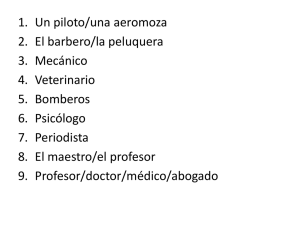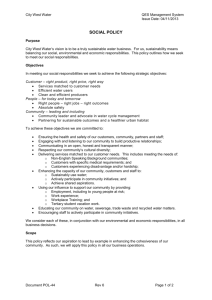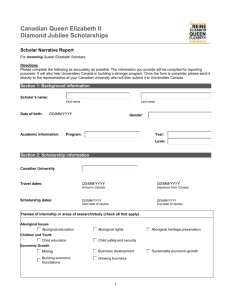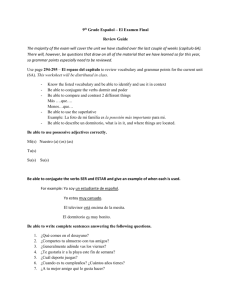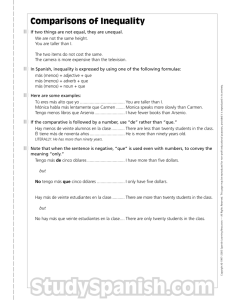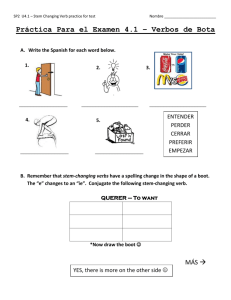Document 10993528
advertisement
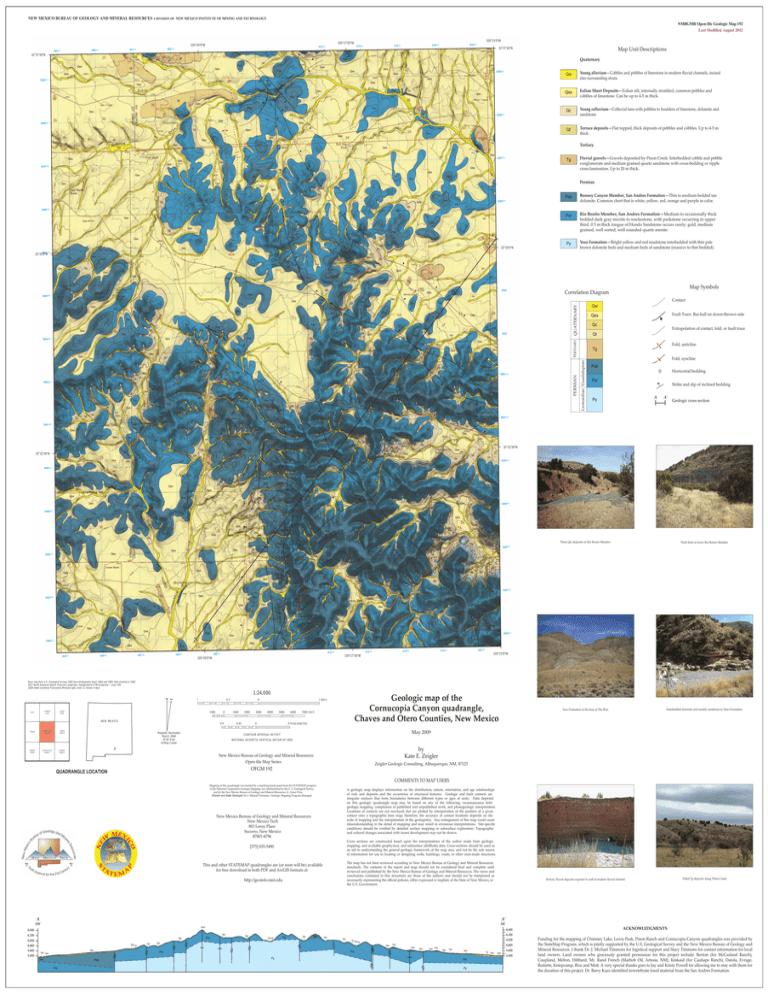
NEW MEXICO BUREAU OF GEOLOGY AND MINERAL RESOURCES A DIVISION OF NEW MEXICO INSTITUTE OF MINING AND TECHNOLOGY NMBGMR Open-file Geologic Map 192 Last Modified August 2012 Psr o Qal 8 Psb Qes o v ! : : ! 3609000 ! ! Psr ! ! Psb ! o ! ! ! ! ! Tg Psr ! ! ! : Qes o ! o ! ! o ! ! ! F ! : ! ! ! ! ! M ! ! ! o o o o o o o o o o M Interbedded dolomite and muddy sandstone in Yeso Formation. ¢ȱĚȱȱ¡ȱȱ ȱȱȱĚȱǯ Tilted Tg deposits along Piñon Creek : o M ! o ! o M ! Psr o M o : Qc : 3596000 : Qal Psr Psb Psr Qal Qc 476000 475000 474000 105°15'0"W 105°17'30"W Geologic map of the Cornucopia Canyon quadrangle, Chaves and Otero Counties, New Mexico 7000 FEET 0.9 KILOMETER May 2009 NATIONAL GEODETIC VERTICAL DATUM OF 1929 TANNER RANCH by Kate E. Zeigler New Mexico Bureau of Geology and Mineral Resources Open-file Map Series Zeigler Geologic Consulting, Albuquerque, NM, 87123 OFGM 192 COMMENTS TO MAP USERS Mapping of this quadrangle was funded by a matching-funds grant from the STATEMAP program of the National Cooperative Geologic Mapping Act, administered by the U. S. Geological Survey, and by the New Mexico Bureau of Geology and Mineral Resources, (L. Greer Price, Director and State Geologist, Dr. J. Michael Timmons, Geologic Mapping Program Manager). A geologic map displays information on the distribution, nature, orientation, and age relationships of rock and deposits and the occurrence of structural features. Geologic and fault contacts are irregular surfaces that form boundaries between different types or ages of units. Data depicted on this geologic quadrangle map may be based on any of the following: reconnaissance field geologic mapping, compilation of published and unpublished work, and photogeologic interpretation. Locations of contacts are not surveyed, but are plotted by interpretation of the position of a given contact onto a topographic base map; therefore, the accuracy of contact locations depends on the scale of mapping and the interpretation of the geologist(s). Any enlargement of this map could cause misunderstanding in the detail of mapping and may result in erroneous interpretations. Site-specific conditions should be verified by detailed surface mapping or subsurface exploration. Topographic and cultural changes associated with recent development may not be shown. New Mexico Bureau of Geology and Mineral Resources New Mexico Tech 801 Leroy Place Socorro, New Mexico 87801-4796 Cross sections are constructed based upon the interpretations of the author made from geologic mapping, and available geophysical, and subsurface (drillhole) data. Cross-sections should be used as an aid to understanding the general geologic framework of the map area, and not be the sole source of information for use in locating or designing wells, buildings, roads, or other man-made structures. [575] 835-5490 The map has not been reviewed according to New Mexico Bureau of Geology and Mineral Resources standards. The contents of the report and map should not be considered final and complete until reviewed and published by the New Mexico Bureau of Geology and Mineral Resources. The views and conclusions contained in this document are those of the authors and should not be interpreted as necessarily representing the official policies, either expressed or implied, of the State of New Mexico, or the U.S. Government. This and other STATEMAP quadrangles are (or soon will be) available for free download in both PDF and ArcGIS formats at: http://geoinfo.nmt.edu A A' SW NE Psb? 6,400 6,400 Qal 6,200 Qal 6,000 Qal Qc 6,800 5,400 Yeso Formation at the base of The Rim. 3597000 Qal Qes CONTOUR INTERVAL 40 FEET QUADRANGLE LOCATION 5,600 QUATERNARY M ! ! ! ! ! ! o o : ! ! ! : : : : : : : : o ! : : : 0 6000 M o : : o o o 5000 Py Py Qc 473000 1 MILE 4000 Leonardian Guadalupian : : : o o ! o Magnetic Declination March, 2008 8º 45' East At Map Center 0.45 3000 TERTIARY o : o o : o o o : ! o : o o CORNUCOPIA RANCH ! o : o : o INDIAN DRAW PINON RANCH 2000 PERMIAN o o o o o : o o CORNUCOPIA CANYON PINON 0.9 1000 o o o o o o o : o NEW MEXICO 0 J o o 1000 0 Qc Qc Psb 1:24,000 LEWIS PEAK J o 105°20'0"W 0.5 ! 472000 1 CHIMNEY LAKE 7 Qc 8 Qes 469000 Base map from U.S. Geological Survey 1965 from photographs taken 1964 and 1965, field checked in 1965. 1927 North American datum, Polyconic projection, reprojected to UTM projection -- zone 13N 1000-meter Universal Transverse Mercator grid, zone 13, shown in blue AVIS ! 468000 467000 466000 Qc 6 17 Psr Psb Qes 465000 ! ! ! ! 5 Psr Qes e ! ! ! ! Qes Qes 8 Qes o Qes Qes Psb Qes Qc J Qes Thick beds in lower Rio Bonito Member. Qc o 7 Psb A Psb 3596000 7 ! o Qal Qes Thick Qes deposits on Rio Bonito Member. 3598000 Qes Qal Psb Qc ! ! Qes o ! o 10 Py Qc Psr Qes Qes 8 Qes Qes Qal Py Qc ! 35 Qes 34 Qc ! Qes Psb Qes o Qc Qes Qes 9 Qal o Qal Qc 7 Py ! 14 Psb 4 15 Psb Qes o Psb Psb Qc o Tg 3597000 o Py 4 7 Psb 4 in ! o Psb Qes Qc Qes ! Qc o Qes Psr 7 ! Qes 13 Tg Geologic cross section ! 9 Qc Qes Qes A' 32°32'30"N 15 ! Psb Py Psb Qes A Py ! Qes Psb 3 8 Strike and dip of inclined bedding 3599000 Qes Qes Psb o 50 ! Qes Qc Psb Qes Psr ! Qes Psb Qes 10 ! Qc Horizontal bedding ! Qes o Qes ! Qc Qes Psb ! 8 Qes Qc Psb Fold, syncline 3600000 Qc 5 26 M 5 18 o o 5 Qc o Py Qes o 9 Qes Qc 7 o e Psb Qes Fold, anticline 10 Qes Qes Qes : Qes Tg Qes ! 10 Qt ! Qc 7 3598000 12 4 Psb o Psb 32 o 6 4 8 o o Qc o Psr 5 3599000 o Qes Psb Psb Psb Qes o Psr Qes 10 : Qal Qc Qes 15 Psr Psr Qes : Qc Qc Qc Extrapolation of contact, fold, or fault trace 3601000 6 Qes Qc Py Py 13 25 Qc Qc Qes Qes Qes 3 Qc Qes Psr Qc Psr 5 8 Psb Psb Qc Py Qc Psb 19 Psb Py Qes Qc ! Psb Qc 5 6 Tg Qes : Qes Py Psb Psr o :: 10 Psb Qc Qes : Qes Qc ! Qes 5 Psb 4 Qes Psb 3 Psb Qc Qc Fault Trace. Bar-ball on down-thrown side Qes ! o e Qes Qal Qc 20 Psr Qes Psr 10 Psb 16 o o Psr Qc o Psb Psr 10 ! 4 Qes Psb Qc Qal ! Qes Psr o 3 Qal 3602000 o Psb : 14 12 Psb Qes 15 ! Qes 3601000 J Psr o Qes ! Tg Qes : Qes 16 Qc ! 10 Psr Qc Qc Psb 9 Psb Qes Qc : 5 ! Qc Qc Qc Qc ! 3 Psr o o Psb Psr o o 64 Psr 3603 o Qc Qes Qes Qc Qes o Correlation Diagram 8 Qc 12 Qc Qes 10 M Psr Qes Qc ! Qes Qc 5 Psb ! 5 o o o Qc o 9 : Psr Qc o Qes : Qc o Qc Psr 3602000 Psr Qes 4 Qal Qc 9 o Qes Psb : 9 8 7 10 : ! Psb Qes Qc Qc o ! Map Symbols Contact ! 10 Qal ! : o Qes Qc Qc ! 6 Qc Psb Psr Qes Psb Psb Qes Qes e 5 ! o o : Qc Psb 3600000 Qc Qc 7 Psr ! 9 Psr 8 5 o ! Qc Qes Qes 3604 Psb 2 ! Psb 3603000 ! Qc Psb ! : Qes 4 o : o Qc Qes 14 Qes ! Psr : 5 : M ! Psb Qc Psb 15 ! 5 o Psb Psr o 3 Psr Tg Psr : 18 Tg Qes Qc Psb Qes Psr 32°32'30"N : o Psr 32°35'0"N Yeso Formation—Bright yellow and red mudstone interbedded with thin pale brown dolomite beds and medium beds of sandstone (massive to thin bedded). Py Qal Qes Qc Psb e o Psb Qes 3 Qc Psb Psb 5 Qes : Qc Psr 6 Psb Qes Qes Psr 6 3604000 Tg Tg o Qc Qes Psb Psb A' 4 : Qes Psb 5 Qes Psb 8 6 Qc 5 o Qes :o ! @ Psr Qes o o Psb o ! @ Qc Psb 8 F @ 4 Rio Bonito Member, San Andres Formation—Medium to occasionally thick bedded dark gray micrite to wackestone, with packstone occurring in upper third. 0.5 m thick tongue of Hondo Sandstone occurs rarely: gold, medium ǰȱ ȱǰȱ ȱȱĵȱǯ Psr Qal Qes ! @ o ! @ 6 29 4 5 Qes 10 Qes o ! Qes o Psb ! Qes Psb ! @ o 10 Psb Psb Psb 5 o ! @ Qc 6 5 6 3606000 Psr Qc 7 o ! 6 3605000 32°35'0"N o Psr o 6 5 o @ Qes : Qes 11 Qes Qes Qes 28 3606000 Psb Bonney Canyon Member, San Andres Formation—Thin to medium bedded tan dolomite. Common chert that is white, yellow, red, orange and purple in color. Psb 5 Qes : o Qc Permian Qes o 6 Qc o Fluvial gravels—Gravels deposited by Pinon Creek. Interbedded cobble and pebble ȱȱȱȱĵȱȱ ȱȬȱȱȱ cross-lamination. Up to 20 m thick. Tg 10 o o o ! ! Qes Qc 3607000 o 2 3 Qes 5 Psb Psr Psr o Qes Qes Psb Qes Qes : Psb 9 Qc Tertiary 5 o o : Psr 5 ! 4 Qes Terrace deposits—Flat topped, thick deposits of pebbles and cobbles. Up to 4-5 m thick. ! o 9 ! o Qes 10 Qes Qt Psr Psr ! oM ! Qes Young colluvium—Colluvial fans with pebbles to boulders of limestone, dolomite and sandstone Tg Qes 5 ! Qes Qc Psr ! ! ! 6 Qes 5 Eolian Sheet Deposits—ȱǰȱ¢ȱęǰȱȱȱȱ cobbles of limestone. Can be up to 4-5 m thick. 3608000 Qes Qes ! ! ! o Qes 3607000 Qes Psr : ! ! 5 ! Qes Qes Psr ! ! ! Qes Psr Psb Qes F o 4 Young alluvium—ȱȱȱȱȱȱȱĚȱǰȱȱ into surrounding strata. F ! ! Qal Psr Qes Qes Qes Qes Qal Qes :: ! ! Psr Psb Qes 3609000 Qes Qes ! Qc : Qes Psr Qes M 3608000 Qes Psb ! 8 Qes Qes : 4 o Psr Qes e ! o Qes Quaternary 10 4 ! Qt 4 : ! Qes o Psr 8 M Qes Qes 5 Psb Qes Qc : Qt : o 2 : Map Unit Descriptions 32°37'30"N Psb Psr o o Qes 7 Qt Psr o Psr 10 Qes o 32°37'30"N o Psb Qc 10 476000 475000 474000 473000 472000 : 468000 467000 466000 465000 105°15'0"W 105°17'30"W 105°20'0"W Qes Psb Psr Qal Qal Qc Qal Psr Qal Psb Qal 6,200 Qal 6,000 Qc Qal Qc Qes Psr Psr Qal Qes Qes Qal Psr Py Psb Psb Qes Qes Psb 6,800 Qes Qal Qes Tg Qes Qes 5,600 5,400 Psr Py ACKNOWLEDGMENTS Funding for the mapping of Chimney Lake, Lewis Peak, Pinon Ranch and Cornucopia Canyon quadrangles was provided by the StateMap Program, which is jointly supported by the U.S. Geological Survey and the New Mexico Bureau of Geology and Mineral Resources. I thank Dr. J. Michael Timmons for logistical support and Stacy Timmons for contact information for local land owners. Land owners who graciously granted permission for this project include: Benton (for McCasland Ranch), Coupland, Melton, Hibbard, Mr. Rand French (Marbob Oil, Artesia, NM), Kinkaid (for Cauhape Ranch), Datola, Evrage, Rodarte, Kniepcamp, Rice and Mott. A very special thanks goes to Jay and Kristy Powell for allowing me to stay with them for the duration of this project. Dr. Barry Kues identified invertebrate fossil material from the San Andres Formation.
